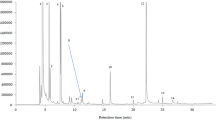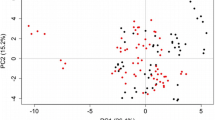Summary
Thirty-three fermentations of Pedro Ximénez grapes, collected in three degrees of ripeness, were carried out by inoculation with three types of inoculum: pure cultures ofSaccharomyces cerevisiae races and ofTorulaspora delbrueckii, indigenous yeasts, and mixed cultures of indigenous yeasts enriched with the pure cultures. By means of variance analysis 21 compounds were determined whose final concentrations in the wines significantly depended on the musts, the inocula or both. Eleven products that depended significantly on the inocula were subjected to a discriminant analysis in which most of the pure cultures gathered in a discriminant space area different from that occupied by the indigenous yeasts. The centroids corresponding to most of the mixed cultures were shifted to the central area of the discriminant space, moved away from their corresponding pure cultures and approached the indigenous yeasts. The results show a high similarity between the fermentations carried out with mixed cultures with the addedS. cerevisiae races and those fermentations carried out with the indigenous yeasts, with regard to those compounds which were significantly dependent on the inocula.
Similar content being viewed by others
References
Amerine, M.A., R.E. Kunkee, C.S. Ough and A.D. Webb 1982. The Technology of Winemaking, 4th edn. AVI Publishers Co., Westport, CT.
AOAC. 1970. Official Methods of Analysis, 11th edn. Association of Official Analytical Chemists, Washington, DC.
Bayonove, C., Z. Gunata and R. Cordonnier. 1984. Mise en évidence de l'intervention des enzymes dans le développement de l'arôme du jus de muscat avant fermentation: la production des terpenols. Bulletin de l'O.I.V., pp. 643–644, 741–758.
Benda, I. 1982. Wine and brandy In: Prescott and Dumm's Industrial Microbiology, 4th edn. (G. Reed, ed.), pp. 293–402. McMillan Publishers, London.
Cabrera, M.J., J. Moreno, J.M. Ortega and M. Medina. 1988. Formation of ethanol, higher alcohols, esters and terpenes by five yeast strains in musts from Pedro Ximénez grapes in various degrees of ripeness. Am. J. Enol. Vitic. 39: 283–287.
Crowell, E.A. and C.S. Ough. 1979. A modified procedure for alcohol determination by dichromate oxidation. Am. J. Enol. Vitic. 30: 61–63.
Diaz, M.I. 1979. Contribution a l'étude des substances volatiles des raisins et des vins de Muscat. Thèse 3ième Cycle, Université de Bordeux II.
Fagan, G., R. Kepner and A. Webb. 1981. Production of linalool,cis andtrans nerolidol andtrans-trans farnesol bySaccharomyces fermentati growing as a film simulated wine. Vitis 20: 36–42.
Fleet, G.H., S. Lafon-Lafourcade and P. Ribereau-Gayon. 1984. Evolution of yeasts and lactic acid bacteria during fermentation and storage of Bordeaux wines. Appl. Environ. Microbiol. 48: 1034–1038.
Gunata, Z., C. Bayonove, R. Baumes and R. Cordonnier. 1986. The aroma of grapes. I. Extraction and determination of free and glycosidically fractions of some grape aroma components. J. Chromatogr. 331: 83–90.
Harrison, J.S. and H. Rose. 1971. The Yeast. Academic Press, New York, NY.
Heard, G.M. and G.H. Fleet 1985. Growth of natural yeast flora during the fermentation of inoculated wines. Appl. Environ. Microbiol. 50: 727–728.
Hock, R., I. Benda and P. Schreier. 1984. Formation of terpenes by yeasts during alcoholic fermentation. Zeitschr. Lebensm. Unters. Forsch. 179: 450–452.
Kreger-van Rij, N.J.W. 1984. The Yeasts. A Taxonomic Study. Elsevier, Amsterdam.
Mauricio, J.C., J. Moreno, M. Medina and J.M. Ortega. 1986. Fermentation of “Pedro Ximénez” musts at various temperatures and different degrees of ripeness. Belg. J. Food Chem. Biotechnol. 41: 71–76.
Millan, C. and J.M. Ortega. 1988. Production of ethanol, acetaldehyde and acetic acid in wine by various yeast races: role of alcohol and aldehyde dehydrogenases. Am. J. Enol. Vitic. 39: 107–112.
OIV. 1978. Recueil des Méthodes Internationales d'Analyse des Vins. Office International de la Vigne et du Vin, Paris.
Ribereau-Gayon, J. and E. Peynaud. 1960 Traité d'Oenologie. Tome 1, Maturation du Raisin, Fermentation Alcooliques, Vinification. Dunod, Paris.
Sponholz, W.R. and H.H. Dittrich. 1974. The formation of fermentation by-products which bind SO2 of higher alcohols and esters by several yeasts and by enologically important wild yeasts. Wein-Wissenschaft 29: 301–314.
Williams, P., C. Strauss, B. Wilson and R. Massy-Westropp. 1982. Studies on the hydrolysis ofVitis vinifera monoterpene precursors compounds and model monoterpene β-d-glucosides rationalizing the monoterpene composition of grapes. J. Agric. Food Chem. 30: 1219–1223.
Wucherpfennig, K. and G. Bretthauer. 1970. Formation of volatile aroma components in grape wine as a function of the pre-treatment of the must and of the used yeast strain. Mitt. Rebe Wein Ser. A (Klosterneuburg) 20: 36–46.
Author information
Authors and Affiliations
Rights and permissions
About this article
Cite this article
Moreno, J.J., Millán, C., Ortega, J.M. et al. Analytical differentiation of wine fermentations using pure and mixed yeast cultures. Journal of Industrial Microbiology 7, 181–189 (1991). https://doi.org/10.1007/BF01575881
Received:
Revised:
Accepted:
Issue Date:
DOI: https://doi.org/10.1007/BF01575881




